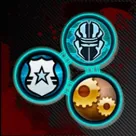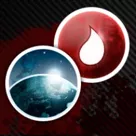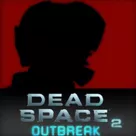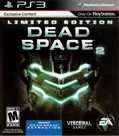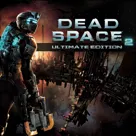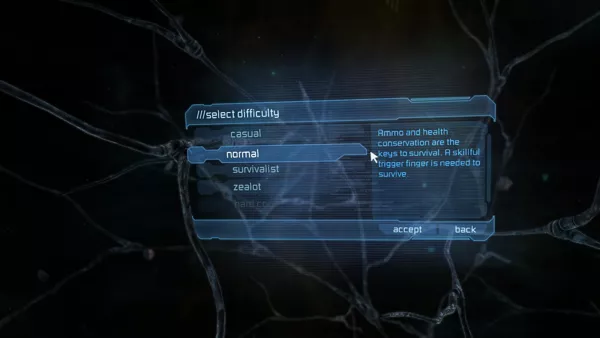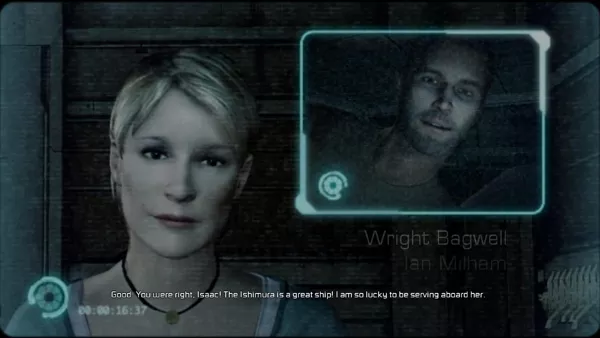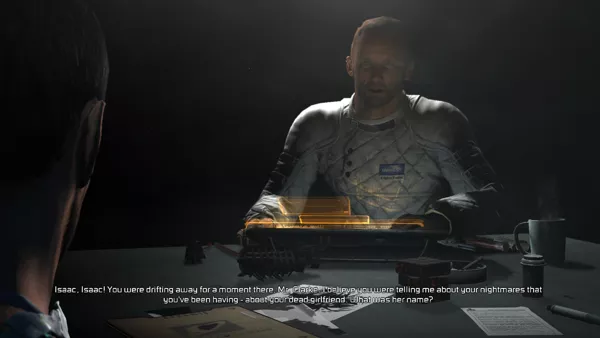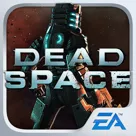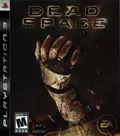Dead Space 2
Description official descriptions
In the follow-up to 2008's Dead Space, players once again take on the role of Isaac Clarke. He is an engineer who previously fought the hideous "Necromorphs" - a race of polymorphic (shape-changing) parasitic extraterrestrials that feed off of dead tissue and use dead corpses as hosts - aboard the doomed "PlanetCracker", the space ship USG Ishimura. Three years after those events, Clarke is found derelict in space and brought aboard The Sprawl - a massive space station orbiting Titan, one of the moons of Saturn. Isaac is understandably traumatized by the events of the first game and is haunted by memories of his girlfriend Nicole's suicide, the horrific and numerous shapes and forms of the Necromorph horde, and continued delusions of an apparition taking Nicole's form. While being psycho-analyzed on The Sprawl, a new Necromorph outbreak soon occurs and Isaac has no choice to escape. He runs from both the Necromorphs and the space station's security team while trying to find a way out of his bonds, grabs a gun, and then learns the truths behind the reappearance of the Necromorphs and the appearance of yet another Marker, all while fighting dementia and even more hideous beasts than before.
Dead Space 2 looks and plays almost exactly like its predecessor. Players control Isaac using a third-person camera. Isaac carries a weapon in hand and must aim the weapon before it can be fired. Each weapon has an alternate attack and players are once again given the ability to use Stasis to slow down objects or enemies, as well as use the telekinesis module to grab and fling objects or solve environmental puzzles. Like before, Necromorphs are extremely tough and resilient to standard shots. The best way to kill them is through dismemberment. Various types of Necromorphs react differently to being dismembered and the player must learn the most efficient way to take each different type apart. He also can use dismembered limbs, such as blade-like arms or one particular species' explosive sack, as weapons that can be flung with telekinesis all the while saving some precious ammo. Isaac can now also control his movement when in zero-gravity and fly around, instead of just jumping from platform to platform. This provides more room for exploration and new possibilities in such areas.
Beyond this the changes are mostly cosmetic, with a broader visual design. Isaac is also voiced this time and is written more deeply into the story. The PlayStation 3 release of the game comes with an updated version of Dead Space: Extraction, a rail shooter originally released for the Wii in 2009 and optimized for high definition and PlayStation Move.
Groups +
Screenshots
Promos
Videos
Add Trailer or Gameplay Video +1 point
See any errors or missing info for this game?
You can submit a correction, contribute trivia, add to a game group, add a related site or alternate title.
Credits (Windows version)
937 People (640 developers, 297 thanks) · View all
| Franchise Executive Producer | |
| Director of Product Development | |
| Creative Director | |
| Franchise Art Director | |
| Production Designer | |
| Audio Director | |
| Senior Producer | |
| Producers | |
| Senior Development Directors | |
| Development Directors | |
| Development Managers | |
| Design Leads | |
| Senior Level Designer | |
| Level Designers | |
| [ full credits ] | |
Reviews
Critics
Average score: 89% (based on 61 ratings)
Players
Average score: 4.2 out of 5 (based on 66 ratings with 1 reviews)
The strongest Survival Horror franchise since Silent Hill
The Good
IMPORTANT DISCLAIMER: For those yet to play Dead Space 2 who intend to, DO NOT update the game to patch v1.1 as will it likely stop you from completing the campaign (further down in the “Bad” section is a complete run down of all the game-breaking issues introduced by the patch).
Poor old Isaac Clarke just can’t catch a break in his life.
First, there’s his tenuous career decision to become a Planetary Mining Engineer, which really isn’t all it’s cracked up to be (get it? “Planet-cracking”? Come on… that was good). Being flung into the outer reaches of the universe to fix banged-up mining vessels and crawl through cramped maintenance shafts while wearing a cumbersome, sweaty, metal suit seems like a major pain in the ass to me.
Second, there’s apparently no place in the known universe where the Necromorph outbreak won’t catch up to him.
In the concluding moments of the first game we saw Isaac hurtling away in his escape pod from the crippled, ravaged USG Ishimura, a Planet-Cracker class vessel which had become nothing more than a gigantic, metallic tomb. We thought Isaac had seen the worst the known universe had to offer but hold the phone a minute, because “The Sprawl”, a mining space station built into the last remaining chunk of Saturn’s moon (Titan), makes the Ishimura look like the Queen Mary 2.
DS2 commences by revealing that our classical anti-hero from the first game has become a psychologically-scarred and traumatized man who is now firmly down the rabbit hole, and he’s not just battling the galaxy’s ugliest, travelling freak show this time around; Isaac is fighting his terminal dementia, the shady EarthGov Corporation and the bizarre cult of Unitology and their “Convergence” prophecy. As if he didn’t have enough on his plate.
DS2 couldn’t kick off any more brutally for Isaac. You’re literally dropped knee-deep in the dead (2 points to me for the old school Doom reference), wrapped in straitjacket, without the faintest clue as to what the hell just happened and forced to fend off, not merely an entire spaceship crawling with Necromorphs, but an entire space station this time.
For those bloodthirsty Dead Space veterans wondering what to expect out of this…?
Just. Play. It.
As much I as will attempt to dissect the journey of DS2 and put into words the splendor of it all, some of the things I will describe you’ll just have to experience for yourself to understand what I mean.
The greatest strength of this series is still by far and away the Hollywood-caliber script. Not only because it builds upon the well-written Sci-Fi fable from DS1 but because it is genuinely unpredictable and surprising. I found some of the plot twists and revelations in DS2, particularly at the end of Chapter 5, Chapter 7, Chapter 15 and the start of Chapter 13 really jaw-dropping and I can’t remember the last time I played a game in which I couldn’t figure out the entire story within half an hour of playing it, or at least make an educated guess as to how the ending would turn out.
The most immediate change is of course: Isaac speaks! That’s right, no more of that Gordon Freeman-esque, solitary mute who never utters a sentence while the entire world collapses around him. Isaac Clarke now articulates in great detail the anguish he feels on The Sprawl. The original game received much acclaim for its voice-acting and I’m pleased to say it’s just as superb and authentically mature this time around, though I did think Isaac’s increased profanity was a rather weak attempt at “gritty realism”. F-Bombs notwithstanding, DS2 features a larger dose of in-game cinematics and it’s these dialogues where the emotional and heart-felt voice acting really shines. It’s no surprise since the voice acting cast consists of actors and actresses who have been involved in a number of critically-acclaimed TV series such as CSI, The West Wing, Law & Order and The Shield as well as few high-profile films like The 5th Element and Die Hard 4.0.
The key cast of characters whom Isaac will interact with, typically via video transmissions, is slightly larger than the original’s and yet still as well-delivered; with the exception of Daina, Isaac’s sole saviour for the first half of the game, who was quite forgettable and cheesy in my mind (I found her too similiar to the character of Kendra from the first game). The stand outs in the story were definitely Hans Tiedemann, chief villain for the majority of the story, as well as Ellie Langford, the unlikely and at-first unwilling ally of Isaac Clarke, a very Alyx Vance-type female accomplice; tough, tomboyish and no-nonsense.
Veterans of the first game will feel right at home in DS2’s adventure, thanks to a number of similarities that parallel certain events in DS1. The introductory sequence featuring Isaac defenceless and running for his life, the unseen and unknown female accomplice that guides you for the first 5 chapters, the central use of a tram as your primary means of advancing to different sectors of The Sprawl; all of these motifs echo the first game almost ad verbatim. However, before you get the impression the script writers had a vacation half-way through development; these tie-ins and references are very complimentary and reward attentive veterans of the first game with nice little touches of nostalgia, rather than simply recycling old concepts.
In much the same way that System Shock 2 or Deus Ex: Human Revolution drop many clues and flash-backs that refer to their prequels, DS2 seeks to build a sense of continuity and a dynamic, “living” world that evolves with the player as they play each successive installment.
This is why I cannot emphasise enough that you play the first game before DS2, as there are so many crucial plot tie-ins, references to events in the first game and nice little touches of déjà vu to be found pretty much throughout the entire campaign.
Once again DS2’s campaign, in much the same fashion as the first game, retains a high degree of replayability through the array of customisation options open to the player’s inventory, weapons, RIG (suit) as well as playing style. There are also the expanded difficulty settings, including an unlockable “Hardcore” mode, which I’ll cover in more detail later on.
Isaac Clarke, being the knowledgeable engineer that he is, can modify and upgrade his weapons and space suit at work benches scattered throughout The Sprawl. Basically there’s 5 universal statistics you can slowly upgrade for most weapons in the game: primary-fire damage, ammunition capacity, rate of fire, alternate-fire damage and reload time. A few weapons have unique statistics not possessed by other weapons, and then there’s Isaacs RIG, which you can upgrade the hit points, stasis duration and oxygen capacity of. This twist of RPG flavour is basically what will you keep coming back for more, as the room for experimentation with differently customised weapons is endless and since you’ll rarely have a chance to amass enough “Power Nodes” to upgrade all 4 of your equipped weapons to their maximum potential, each play through allows you to focus on something different that you hadn’t tried before. The upgrade “circuits” are laid out in such a way as to allow you to maximise one aspect of a weapon at a time, such as damage or ammo capacity, forcing you to choose which you value more and what kind of playing style you’ll adopt.
Of course DS2 wouldn’t be a very good sequel if it was a mere rehash of the first game, and naturally to keep things innovative and exciting, DS2 includes a whole new plethora of reanimated baddies hell-bent on killing you, along with a host of new tools to prevent that from happening.
Four additional weapons accompany Isaac’s already potent arsenal (certain pre-ordered editions of the game & DLC packs do come with exclusive weapons, but I won’t cover these as they’re not part of the default inventory) and roughly 8 new Necromorph types await you in the deserted depths of The Sprawl, ready to carve up Isaac like a thanksgiving turkey.
I must admit I found myself largely ignoring the new arsenal of weapons in DS2 and sticking to my trusty tools of the trade I mastered in DS1: the Plasma Cutter, Line Gun, Plasma Rifle and Contact Beam. Fully upgraded and properly utilised, these bad boys are the only weapons you’ll need to complete the game on any difficulty and while some of the new weapons are quite novel, particularly the Detonator which has an infinite number of uses as both an offensive and defensive weapon, they’re not suited to the faster-pacing and higher enemy count of DS2.
Unlike the lackluster weaponry though, the new Necromorph types significantly alter the nature of combat in this game and are perhaps, along with the new-found telekinesis impalement ability, the two biggest changes to the combat experience. The most memorable enemy type is without a shadow of a doubt the “Stalkers”, which is the first Necromorph variety encountered in the series so far to do more than simply charge straight for you while howling all manner of creepy vocalisations. I liken them a lot to the Velociraptors of Jurassic Park fame and it seems this was the developer’s intention also, as there’s an achievement trophy on the Xbox 360 version of the game called “Clever Girls”, which should ring bells for anyone who’s watched Jurassic Park. The Stalkers are cunning, fast-moving, intelligent pack hunters that close off your escape routes and corner you.
It’s such a treat in a Survival Horror game to be able to go up against enemies who use a modicum of tactics and cover, as the par for the course with most Survival Horror franchises tends to be some form of undead creature that can do little more than walk or run in a straight line towards you.
A few of the other memorable, flesh-eating monstrosities you’ll come across also include “The Pack”, essentially “necrotised” children who use strength through numbers to overwhelm you and the incredibly annoying “Pukers”, the only Necromorphs with a ranged attack that consists of launching gobs of corrosive bile, which after hitting you, slows Isaac’s movement considerably for several seconds. They’re especially nasty to deal with because at close range even when you blow off a limb or stomp their corpse you get showered in their acidic blood (think of the film Aliens), thus damaging you even after they’re dead. The enhanced version of the Puker is probably one of the most difficult enemies in the game, along with the “Crawler”, the only enemy in the game with the ability to scale walls and ceilings (and they’re fast), meaning they can sneak up on you from almost any angle.
The primary difference in the combat dynamics of DS2 as opposed to the original is the increased emphasis on turning environmental objects, particularly severed enemy limbs, but also explosive barrels and stasis canisters into deadly missiles with the use of your telekinesis ability. This is so strongly hinted at during the first few chapters of the game that the level designers littered the levels with a plethora of sharp, pointed objects for you to hurl such as brooms, metal poles, tools and later on severed Necromorph limbs/bones (which you can peel off dead Necromorphs with telekinesis). There’s even an in-game tutorial video you’ll come across which will tell you in no uncertain terms to start flinging crap off the ground at your enemies (a sad reminder that developers think little of the average gamer’s intellect).
Most physics-enabled objects, whether they’re intended to cause damage or not can be tactically employed to great effect; some examples included using large pieces of furniture (i.e. tables) as shields or make-shift barricades to prevent Necromorphs from over-running you and repeatedly bludgeoning enemies with chairs or garbage cans (which is effective against smaller Necromorphs like The Pack).
This combat mechanic will be immediately familiar to any gamer who’s used Half-Life 2's Gravity Gun. On the harder difficulty levels, the telekinesis power MUST be exploited to the upmost degree for the player to have any chance to amass a consistent supply of ammunition. And above all else, it’s just a flat-out joy to impale those hideous monstrosities against walls and skewer them like kebab meat.
The other significant change to Isaac’s repertoire is his increased mobility in zero-gravity environments. In DS1, you were basically tethered to the floor, walls or ceilings of a zero-g environment via your magnetic boots and could only relocate to a different surface that was close enough and flat enough for you to land on by executing these Superman jumps. Now your RIG comes equipped with miniature rocket thrusters which basically give you full, unhindered, 360 degree movement in mid-vacuum. To me I was instantly reminded of Boba Fett from Star Wars the moment I found myself hovering in space and raining death upon the Necromorphs.
One final gameplay change I will go over, and arguably the most jaw-droppingly fun addition Visceral came up with in disposing of Necromorphs, are the “rapid decompression” events encountered when unreinforced glass windows in certain rooms are broken (either by you or occasionally by Necomorphs themselves). These sections of the game act much like a passenger plane experiencing explosive decompression at high altitude, basically giving you the ability suck absolutely everything out through the window like a high-pressure vacuum cleaner.
This means any and all Necromorphs, furniture, loose debris and physics clutter… all of it is headed for the abyssal planes of deep space… as well as YOU. Though Isaac’s saving grace is of course is his magnetically-tethered RIG, which will slow his exit to the window to a fast drag along the floor, as opposed to being flung out instantaneously.
With these few short seconds of life, Isaac can stop himself being catapulted into neighbouring Saturn’s asteroid field by firing a well-placed shot at a glowing, red sensor right above the window which will snap shut an “emergency” hatch over the gap, thus sealing the room again.
While these action movie-styled, explosive decompressions look fantastic and make for an exhilarating roller-coaster ride of tension (steadying your aim while Isaac is inching closer to the window always made me tense up) what they also do is make these sections of the game incredibly easy. Easily hurling a room full of Necromorphs into outer space turns what would have ordinarily been a tough encounter with multiple enemies surrounding you, into an absolute cake-walk. Unfortunately for the FPS-challenged these decompression windows are not that common, which is a relief in a game that has had a ton of difficulty concessions added into it (more on that in the Bad section).
A brief word on the environments of DS2 is mandated, as I consider this to be a massive improvement over the original. While DS1’s level design can’t be faulted on technical terms as it was very realistic and well thought-out (in terms of modelling a futuristic space mining vessel), you cannot deny it got repetitive and at times too claustrophobic.
On the whole DS2’s levels are far more well-crafted, diverse and visually breath-taking. Just to name a few of the locales you’ll be visiting; everything from a 26th century shopping mall to a grandiose Unitologist cathedral (with an awesome cryogenic crypt) and even an off-world, elementary school is rendered in beautiful detail and really does build up some memorably haunting encounters. The Unitologist cathedral instantly evoked Quake 2 for me; I found its layout and over-the-top ornamental architecture very similar to the Strogg’s Inner City.
The environment that stands out above all others though, in terms of imagination and evocativeness is quite literally “dead space”. Without giving away too much more (because it’s such a wonder to behold for the first time), at one point during the campaign Isaac will find himself floating several miles above the entire Titan Station, and boy did this whole scene leave my jaw dropping.
The realisation that you are one of the few living survivors on The Sprawl, and the lonesome feeling that descends upon you as you float in the disorienting vastness of space and gaze into the mind-boggling abyss of the entire Solar System, which is devoid of anything comforting or familiar; I can’t exaggerate enough how evocative that scene was as an analogy for the entire campaign: One man, in the middle of nowhere, with almost nothing to rely on. We terrestrially-based humans really do forget the incomprehensible expanse of nothingness that we are floating in and just how lonely and insignificant we all are, but the nihility of space was really driven home by that very scene.
All of the environments are dripping with atmosphere and creativity and like in the first game, a true sense of belonging. If the eggheads at NASA ever draw up blueprints for a future, deep-space mining station, I’d wager The Sprawl would be it. Everything just fits, pure and simple.
On a final technical note, DS2 is still using a highly modified version of The Godfather engine circa 2006, and is still an entirely DirectX 9 game. Which considering the aging technology, may come as a surprise considering how damn good the game looks. The latest incarnation is known as the “Visceral Engine” and while it is not a significant leap forward over DS1, you really can’t find much to complain about, and the subtle yet welcome addition of anti-aliasing, enhanced motion blurring and depth of field help to keep it competitive with the over-abundance of graphics porn-oriented games out there.
I did mention at the start of the review that I intended to talk about the “Hardcore” difficulty mode, and well, here it is (I really didn’t know where else to fit it into this already lengthy essay).
In light of a number of horror-distilling difficulty concessions which I’ll elaborate on in the Bad section, those looking for a traditional, pain-snakingly tense and nerve-wracking Survival Horror experience are highly recommended to try their hand at “Hardcore” difficulty.
This level of difficulty, which is enabled once you complete DS2 on “Survivalist” or “Zealot” difficulty, made waves throughout gaming forums and websites for good reason: it is exactly what it sounds like. Get this: you get 3 saves to use. Not for every chapter. But for the entire duration of an 8 to 10 hour campaign.
Not only that, but automatic “checkpoint” restarts, found in all other difficulty levels, are also gone. So if you die before a boss battle or a “last-stand” situation being swamped by an inordinate amount of spawns… too bad. There are twice as many Necromorph spawns compared to lower difficulties (even in areas which on lower difficulties were completely devoid of any Necromorphs) and pick-ups will be far and few in between. Welcome to the big leagues rookie.
The Bad
With all the glowing praise and sentimental gibberish I’ve just spouted about the game, you might be forgiven for assuming I feel this game is perfect and without any flaws whatsoever and that I’d have to be bipolar to do a complete 180 and suddenly lambast it to smithereens.
But… that’s exactly what I’m going to do. And here’s why: video game sequels suck. We are all acutely familiar with this unwritten rule of the video game industry and it’s just compounded by the fact that this is a sequel published by Electronic Arts, the reigning champions of destroying once successful and critically-acclaimed video game franchises.
This trend is as regular as a German subway system: the developer hits the big-time with the first game, the publisher gets greedy and pressures the developer to appeal to a broader audience, the developer stops responding to the fan base’s complaints and suggestions and proceeds to milk the cash cow for all it’s worth with promises of reliving the original glory of the first game that never come to fruition.
It’s that school of software development that says, easy on the feature-set in case we confuse the poor idiots.
And if you think I’m just being an “elitist” PC gamer whose standards are too weighted towards PC exclusives and the technical advantages the PC platform possesses, then please, allow me to explain myself.
To start off with, one of the most hated aspects of the original game were those annoying “back-tracking” segments in the campaign where you had to walk through the empty, deserted corridors of the Ishimura you had already visited so you could unlock or otherwise overcome whatever obstacle was in your way. Unfortunately, these segments make a comeback in DS2. Though their frequency seems slightly lower than what was encountered in DS1, I still find them rather mind-numbing, because little has changed since you last visited that particular location 10 to 20 minutes ago. Often there aren’t even any new enemies spawning in the areas you’ve cleared out, which creates a massive lull in the action.
This next negative criticism I hate to bring up because it’s just about attached to every single multi-platform title that has to be ported to the PC from a console, but DS2 does feel inherently “dumbed down” and suffers from rather prominent “consolitis” (hint: Google). Keen observers will note the useful, 3D mini-map included in DS1 is absent in DS2 and as a result, the game has been linearized to a far greater degree which absolutely astounds me.
DS2 is set in a location infinitely larger than the cramped Ishimura and yet we’re given less room to play with?
In many instances in the first game, arriving at a new chapter of the campaign would present you with numerous objectives to do before you could move on to the next one. These objectives could be accomplished in any order, and were usually located at opposite ends on a particular deck of the Ishimura (Chapter 6 for example). This at least gave you some minor strategic choices to make, as in do you go for the nearest objective immediately or do you stock up on health and ammo at the store and prepare yourself for the long haul? Gone are these “cerebral” nuances in DS2, along with any semblance of choice or nonlinear gameplay. Level navigation is almost on-rails now.
The objectives menu holds your hand by telling you exactly how to complete a perquisite trigger to unlock the only door/pathway leading to the next area of the game. The quality of the puzzle-solving segments in DS2 is not only amateurish but it’s clear they barely made it into the game at all, serving as mere distractions to fool fans into thinking the sequel hadn’t been dumbed-down. The hacking mini-game for instance, encountered when you run into malfunctioning equipment or locked doors, consists of moving your mouse in a circle and left-clicking when a little wheel icon turns blue. This was undoubtedly designed with gamepad joysticks in mind. System Shock 2 features my personal golden standard of hacking mini-games and compared to that, this is not even a mini-game; it’s more like a jigsaw puzzle with one piece missing. It’s something redundant that doesn’t need to be accomplished to achieve what is essentially a foregone conclusion.
It beggars belief you’re still given the pathfinder beacon which tells you exactly where to go by drawing a neon-line on the floor. Seriousy, how lazy or impatient could you be?
As I mentioned previously, when discussing the increased use of telekinesis impalement in combat, the game now even approaches the level of telling you how to play it.
The in-game tutorials you come across, the extremely conveniently placed explosive barrels, stasis canisters and other environmental “aids” to make fire-fights less of a chore, the more frequent, very scripted boss battles which are in fact easier than facing groups of Necromorphs, the stupid quick-time events that demand you push 'E' repeatedly (obviously designed with consoles in mind), the lack of challenging puzzles, and hell, even the way the store menu looks now, with graphical representations for every item you can purchase (in case you’re not really sure what a med pack does); it all reeks of pandering towards the lowest-common denominator, i.e. the console gamer demographic.
The pacing of the game has also taken a turn for the worse. It’s barely Survival Horror anymore, the campaign moves far too quickly (especially in the later chapters of the game), doesn’t allow you enough time to soak up the disturbing atmosphere and throws far too many enemies in your way to the point where you can predict when they’ll spawn.
It’s just so contradictory how the first half of DS2 is more or less a Survival Horror game, and yet the second half is like a generic and brainless action-shooter with you facing inordinate amounts of respawning monsters and having nearly infinite amounts of ammunition and health lying around. It’s like the game is trying to parody itself, and failing miserably.
Instead of emphasizing distance, cover, planning and precaution, the game forces you into being “boxed in” with roomfuls of Necromorphs and the only conceivable way of success is to left-click like your life depended on it. That’s not Survival Horror, that’s a shooting gallery. Might as well bundle the sequel with a light gun and make it completely on-rails; something like Time Crisis or Virtua Cop.
There’s nothing rewarding nor frightening about having 5 Necromorphs running at you with your back against a corner. It’s sheer frustration. Who do I shoot first? Who’s fastest? Where am I supposed to look? Can they spawn behind me? Do I have time to pick up that loot that just dropped? How many more are coming? Should I reload now?
It also leaves a very unsatisfying feeling watching Isaac Clarke, a friggin’ mining engineer with zero military training and an improvised rock cutting drill in his hand, taking on 20 Necromorphs at a time and coming out on top like he’s in a Sylvester Stallone movie. Do you know what desensitization means Visceral Games? Can any true Survival Horror fan imagine how ridiculous a game Silent Hill would have been if Harry Mason could freely go around stomping the living crap out of the monsters with impunity? Survival horror is about making the player feel helpless, over-whelmed and trapped in a chaotic, incomprehensible situation and all of these stupid, over-the-top antics do the exact opposite. They make you feel invincible and far too confident.
In continuing on from that point, DS2 lacks any real suspenseful or scary vestiges from the original game. Granted the first game wasn’t that scary but they tried so desperately to play up the fear factor in the marketing campaign for DS2, alas you simply can’t embellish what isn’t there to begin with. Don’t fall for it people, it’s not going to be a heart-pounding, bowel-shaking journey like Amnesia: The Dark Descent or Condemned: Criminal Origins.
This over-the-top, “shock and awe” approach featuring even more gratuitous gore (as if there wasn’t enough), bizarre hallucination sequences featuring a zombified Nicole and far more sinister imagery, particularly the recurring inclusion of enemies who represent “necrotized” babies, mass suicides and creepy Unitologist settings didn’t elevate my blood pressure one iota… it’s the fear of the unknown and the lack of a clearly-defined fate in the DS1 that actually made it suspenseful. Ergo DS2 becomes predictable (when the lights go out and the doors magically lock themselves, you know what’s coming) and very contrived.
Wading through swimming pools of blood and being witness to the ordinary citizens of The Sprawl getting dismembered don’t impact on YOU, Isaac Clarke, nearly as much as watching the Necromorphs work in tandem with the traitorous Unitologist officers to cunningly hamper your escape from the Ishimura at every turn in the first game.
The way your hopes of escape were almost dashed in a series of near-catastrophes such as when the communications satellite failed, when the Ishimura was headed right for an asteroid belt, when the air supply on the ship began to plummet… these moments genuinely made you want to resolve the issue at hand as fast as possible. They actually made you sympathise with Isaac’s miserable condition and gave you something to identify with, in this lone, ordinary man going up against a Mount Everest of problems.
In DS2, Isaac lost something in the 3-year hiatus between the events of the first and second game. This unmistakable personality shift from a genuine anti-hero; a bumbling, helpless, geeky engineer who could barely fight his way out of a paper bag to a largely remorseless, tough-guy demeanour felt unrealistic for someone who had been subjected to the immense traumas Isaac had.
The other gratuitous aspect of DS2 that was seldom encountered in DS1 is the increased prevalence of scripted cinematic sequences, often featuring Isaac in some mode of transportation.
These were more or less forgettable and could have easily been done away with to keep the player immersed in the disturbing atmosphere. What would have been even more appropriate, is if these cinematics were turned into mini-games of sorts, perhaps puzzles even, which were far more plentiful in the original game (for example, like the Asteroid Defence System). Giving Isaac the opportunity to put his engineering credentials to good use by say, piloting some kind of vehicle or machine, would fit right into the story.
There are a few other relatively minor gameplay aspects I grew to dislike in DS2, but they are not an innovation over DS1 and are instead found in both games.
The first is the issue of randomized loot. The majority of the pick-ups you will scavenge from enemy corpses and storage containers are randomized (there are some static ones). Great you might say… more replayability value right? Well yes, until you decide you stuffed up one part of the game, reload your last save-game (which will be some time before given how spaced out the save points are), replay that part over again and find yourself picking up loot that is utterly worthless in comparison to the stuff you found in your previous play through. It’s a very inconsistent, purely chance-based system; nothing like traditional RPG “dice-rolling” mechanics which can often be tilted toward the player’s favour by using certain abilities/items.
Numerous times when I went back to an older save-game I found myself amazed by how big the difference in the loot dropped by just 2 or 3 enemies could be. It’s especially noticeable when you kill the harder, “enhanced” Necromorphs (these are covered in charcoal-like flesh), for which the game should compensate you with a fairly hefty reward; a few thousand credits, a valuable semiconductor, a large medpack (worth 5,000 credits), etc. Sometimes however, you simply get ripped off and might just receive 4 plasma cutter rounds or 2 line gun rounds.
(According to other reviews I have read online, the more ammunition of a particular type you carry, the more chance you have of finding that ammunition in randomized loot. I can’t say I found this to be true during my play throughs however. Often at times I would get ammunition for weapons I hadn’t even unlocked/bought.)
One last point about the loot system, due to some engine limitation in DS2, no more than 5 Necromorph corpses can actually be present in the one area at the same time (I believe it was the same for DS1). Normally this isn’t an issue, but as mentioned previously there are quite a few set-piece battles in DS2 in which you’ll encounter 20 plus Necromorphs consecutively (usually respawning in groups of 3 or 4) and since corpses must be stomped or otherwise “damaged” one more time after death for an enemy to actually drop their loot, you can find yourself missing out on loot entirely simply because the enemies are spawning faster than you can kill them and there’s no opportunity for you to actually stomp/shoot the corpses.
I also found it very lacking that amongst the new arsenal of weapons in DS2, not one of them had an automatic rate of the fire. The only real automatic-firing weapon is still the rather weak Pulse Rifle which is only really suitable for mopping up incapacitated Necromorphs or against weaker types. I guess you could argue this fits in well with a survival-horror game that emphasizes ammunition conservation as you do have to make your shots count, but some of the weapons are ridiculously slow-firing to the point where you have to switch to another one after firing one shot; otherwise you’ll be overrun by faster-moving Necromorphs. It just feels like you never really get the chance to show off the potential of some of the weapons in this game due to the close-quarters combat of DS2, thus you always find yourself falling back on the Plasma Cutter when you’re faced with multiple, fast-moving adversaries, and that makes things slightly boring after a while.
There are no bugs or technical issues to speak of fortunately, which as in the original DS1 really surprised the heck out of me for an EA-published game, which these days are usually released in their Beta or sometimes Alpha states.
As per the opening disclaimer, the only problems you could potentially encounter with DS2 arise if you update the game to the completely unnecessary v1.1 patch.
Aside from the fact that this so called “patch” will very likely stop you from being able to complete the campaign, it also introduces numerous physics glitches, causes weapons and items to randomly disappear from your inventory, doors that refuse to open to allow you to progress further, and certain parts of the campaign “breaking” and becoming impossible to complete; and that’s not even the worst of it.
You see, a lot of PC gamers were quite angered to discover that only the consoles would be receiving numerous DLC packs after the launch of DS2 in January, 2011 and EA finally reneged on this issue, in classical EA fashion, by simply unlocking ALL of the DLC content with patch v1.1 FROM THE VERY START of the campaign (essentially a "Give All Weapons & Ammo" cheat). Mind Blown. But wait… there’s more! Turns out, even though EA explicitly denied they would release any DLC for the PC version after launch, the DLC data was already PRESENT on the game’s DVDs, but was simply not accessible by the player in any shape or form.
Yes, this is about as trademark of an asshole move by Electronic Arts as you can think of, “Oh… you want the DLC do you PC gamers? You want to mess with our finely-tuned, exploitative profit margins? FINE, have it! Here, have all of it from the very start of the game so that the entire campaign is now broken and made even more ridiculously easy! There… are you happy now?” The lazy bastards just didn’t want to accept the charges that they had consolized and watered-down the purity of the franchise and were exclusively pandering to the console demographic with their pointless micro-transactions. Buying your way through a game? I’ll pass.
You can safely ignore v1.1 all together, unless you intend on playing DS2’s multiplayer, in which case at least finish the campaign first and then update to v1.1.
Speaking of the multi-player; think of Doom 3’s archaic and stupendously limited 4-player action with a twist of “counter-operative” flavour. It’s a shameless Left 4 Dead rip-off; basically there are 4 humans and 4 player-controllable Necromorphs (along with bots). The humans are tough and resilient but vulnerable alone, whereas the Necromorphs are weak but respawn indefinitely to prevent the humans from reaching their objective before the timer runs out. You get 5 maps with the combined size of a Russian prison cell, that are loosely inspired by events seen in the campaign, which will enable you to quickly discover how repetitive strain injury takes its toll on a human finger every time a Necromorph pounces on you and you’re forced to mash the ‘E’ button.
Let’s not waste any more time on it.
At this point I don’t really have the energy and anyone reading this (and if you still are, well congratulations) really doesn’t have the patience for me to rail against DS2 in even more excruciatingly fickle detail, but there is one last point I’ll finish my gripes with the game on.
You might notice the storyline of DS2 has been spared from my obsessively nerdy, vitriol-laden, self-entitlement, first-world problem rant but it’s not airtight unfortunately and there are some lingering questions that I can’t answer with any reasonable amount of suspension of disbelief nor fan-created theories on the Internet.
A glaring plot-hole and one which I had previously ignored in the first game, believing it to be deliberately left untold so as to build a wonderful climax in the sequel, is the exact mechanism behind The Marker’s ability to spread the Necromorph outbreak. We are told this mysterious artifact can have a disturbing psychological and emotional impact on those exposed to it, causing them to become schizophrenic and psychopathic but no explanation is offered as to how it physically transmits the Necromorph infection to human beings (living or deceased). Is it some kind of a highly contagious viral infection that spreads through direct contact with The Marker? Does The Marker simply summon Necromorphs from another dimension like the demons from Doom 3? Are there Necromorphs actually hiding inside The Marker like a battalion of mutated Trojans? Nothing is mentioned regarding the actual scientific or “spiritual” process by which ordinary human beings within the vicinity of Markers are transformed into horrific, undead abominations which then go on to transform even more unwitting victims. There has to be some starting point for these outbreaks.
This is a de rigour part of the entire story and it is still left up to the viewer’s imagination in the second game in this series? This cannot be seen, in my eyes, as anything less than utterly lazy script-writing.
I guess I could also throw in the inexplicable popularity of Unitology, which seems to defy all logic as to why millions and millions of people would be drawn to this doomsday-worshipping, apocalyptic cult that asks unquestioning obedience of its followers but hey… the truth has been stranger than fiction throughout history. The rise of Hitler and the Nazi ideology is not that far off from an obscure religious sect in DS2 becoming the rulers of the humanity. So I’ll leave it at that.
The Bottom Line
Overall an excellent addition to this hauntingly poetic saga about a classical tragedy that befalls an ordinary man who’s simply in the wrong place at the wrong time. DS2 tops it off with a very Hollywood flair and even bigger production values.
The pressure from gaming giant EA on developer Visceral Studios to give this title a more broad, action-heavy appeal is undeniably evident, and I do concede the hard-core, Survival Horror demographic is a fairly niche part of gamers worldwide, but it does leave a bad taste in your mouth if you jump into DS2 right after DS1, when the differences in gameplay, difficulty and atmosphere are very obvious.
Casual gamers may not agree but it sets a bad precedent, which I seriously do not wish to see repeated in any future sequels of this game. This series has so much potential and room for expansion to become something truly transcendent and memorable, a new standard by which future Survival Horror titles are judged, and boy it’s a been a long time since the Survival Horror genre actually had standards. Hopefully whatever sequel does materialise in the future, will take more cues from the first game, rather than this one.
Nevertheless, I highly recommend it and when taken as a whole experience, it certainly masks it's flaws and shortcomings extremely well with strong writing, great voice-acting, customizable playing styles, a very good amount of replayability, enough selectable difficulty for any gamer's tastes and a wonderful ending.
Windows · by Sharafciger (34) · 2012
Trivia
German version
In the German version friendly fire in multiplayer is deactivated. Users of the German version can play with users of the uncut version, but then friendly fire is deactivated for everyone.
Online servers
The game's online servers were shut down on 8 December 2023.
Awards
- 4Players
- 2011 – Best Sound Effects of the Year
Analytics
Upgrade to MobyPro to view research rankings!
Identifiers +
Contribute
Are you familiar with this game? Help document and preserve this entry in video game history! If your contribution is approved, you will earn points and be credited as a contributor.
Contributors to this Entry
Game added by Kaddy B..
PlayStation 3 added by Charly2.0.
Additional contributors: Patrick Bregger, Plok.
Game added February 7, 2011. Last modified April 7, 2024.

